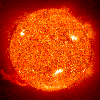 |
||
| First page | ||
 |
||
| Composition | ||
 |
||
| Activity | ||
 |
||
| The Sun as a star | ||
 |
||
| How/Why study? | ||
 |
Importance for us | |
 |
||
| Find out more | ||
 |
||
 |
||
Scientists study the Sun in a number of ways including ground based telescopes and satellites to obtain as much information as possible.
Solar InteriorThe interior of the Sun is too dense to be seen so scientists use a method known as helioseismology to probe the structure in this part of the Sun. Helioseismologists listen to the music of the Sun by studying sound waves which bounce around inside. The reflection of the sound waves off the inside of the photosphere causes the surface to pulsate very slightly, and the rising and falling of the photosphere can be measured to give information on the density and motions of the material within the Sun.
PhotosphereThe photosphere was the first part of the Sun to be studied as it can be seen in white light.
ChromosphereThe temperature of the chromosphere is higher than the photosphere so light emitted by ionised Helium is used.
CoronaThe corona is the hottest part of the solar atmosphere and needs to be viewed in the hottest and most energetic end of the electromagnetic spectrum. This means that instruments which detect Ultra-violet and X-ray radiation are being used.
How do we study flares?
Flares release huge amounts of energy and heat the coronal plasma to many tens of millions of degrees. The energy released is seen through out the spectrum including X-rays, gamma-rays, UV and radio waves, so special instruments are required that are sensitive at these wavelengths.
How do we study coronal mass ejections?
Coronal mass ejections (CME) are detected in white light when the disc of the Sun is occulted by an instrument called a coronagraph. Most of the Sun's light is emitted from the photosphere and this needs to be blocked if the fainter corona is to be seen. The density enhancements of the CME are seen by the scattering of the photospheric light off the electrons in the corona by a process called Thomson scattering.
Never look at the Sun directly. Doing so will destroy the retinas of your eyes.
10th September 2000
Lucie Green
www_astro@mssl.ucl.ac.uk